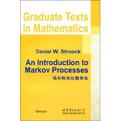马尔科夫过程导论
出版时间:2009-4 出版社:世界图书出版公司 作者:丹尼尔斯特鲁克 页数:171
Tag标签:无
前言
To some extent,it would be accurate to summarize the contents of this book as an intolerably protracted description of what happens when eitherone raises a transition probability matrix P(i…e all entries fP) are non-negative and each row of P sums to 1) to higher and higher powers or oneexponentiates R(P-11,where R is a diagonal mattix With non-negativeentries.Indeed,when it comes right down to it,that is all that is done inthis book.However,I,and others of my ilk,would take offense at such a dismissive characterization of the theory of Markov chains and processes Withvalues in a countable state space,and a primary goal ofmine in writing thisbook Was to convince its readers that our offense would be warranted. The reason why I,and others of my persuasion,refuse to consider the theoryhere as no more than a subset of matrix theory is that to do so is to ignore thepervasive role that probability plays throughout.Namely,probability theoryprovides a model which both motivates and provides a context for what weare doing with these matrices.To Wit.even the term“transition probabilitymatrix”lends meaning to an otherwise rather peculiar set of hypotheses tomake about a matrix.Namely,it suggests that we think of the matfix entry(P) as giving the probability that,in one step,a system in state i will makea transition to state J.Moreover,if we adopt this interpretation for(P)O,then we must interpret the entry(P) of P as the probability ofthe sametransition in steps.Thus,as P is encoding the long time behaviorof a randomly evolving system for which P encodes the one-step behavior,and,as we will see,this interpretation will guide US to an understanding oflim P.In addition,and perhaps even more important,is the rolethat probability plays in bridging the chasm between mathematics and therest of the world.Indeed,it is the probabilistic metaphor which allows one toformulate mathematical models of various phenomena observed in both thenatural and social sciences.Without the language of probability,it is hard toimagine how one would frO about connectin~such phenomena to P.
内容概要
To some extent, it would be accurate to summarize the contents of this book as an intolerably protracted description of what happens when either one raises a transition probability matrix P (i.e., all entries (P)o are nonnegative and each row of P sums to 1) to higher and higher powers or one exponentiates R(P - I), where R is a diagonal matrix with non-negative entries. Indeed, when it comes right down to it, that is all that is done in this book. However, I, and others of my ilk, would take offense at such a dismissive characterization of the theory of Markov chains and processes with values in a countable state space, and a primary goal of mine in writing this book was to convince its readers that our offense would be warranted
书籍目录
Preface. .Chapter 1 Random Walks A Good Place to Begin 1.1.Nearest Neighbor Random Wlalks on Z. 1.1.1.Distribution at Time n 1.1.2.Passage Times via the Reflection Principle. 1.1.3.Some Related Computations 1.1.4.Time of First Return 1.1.5.Passage Times via Functional Equations 1.2.Recurrence Properties of Random Walks 1.2.1.Random Walks on Zd 1.2.2.An Elementary Recurrence Criterion 1.2.3.Recurrence of Symmetric Random Walk in Zz 1.2.4.nansience in Z3 1.3.Exercises Chapter 2 Doeblin’S Theory for Markov Chains 2.1.Some Generalities 2.1.1.Existence of Markov Chains 2.1.2.Transion Probabilities&Probability Vectors 2.1.3.nansition Probabilities and Functions. 2.1.4.The Markov Property 2.2.Doeblin’S Theory. 2.2.1.Doeblin’S Basic Theorem 2.2.2.A Couple of Extensions 2.3.Elements of Ergodic Theory 2.3.1.The Mean Ergodic Theorem 2.3.2.Return Times 2.3.3.Identification of π 2.4.Exercises Chapter 3 More about the Ergodic Theory of Markov Chains 3.1.Classification of States 3.1.1.Classification,Recurrence,and Transience 3.1.2.Criteria for Recurrence and Transmnge 3.1.3.Periodicity. 3.2.Ergodic Theory without Doeblin 3.2.1.Convergence of Matrices. 3.2.2.Ab el Convergence 3.2.3.Structure of Stationary Distributions 3.2.4.A Small Improvement 3.2.5.The Mcan Ergodic Theorem Again 3.2.6.A Refinement in The Aperiodic Case 3.2.7.Periodic Structure 3.3.Exercises Chapter 4 Markov Processes in Continuous Time 4.1.Poisson Processes. 4.1.1.The Simple Poisson Process. 4.1.2.Compound Poisson Processes on Z 4.2.Markov Processes with Bounded Rates 4.2.1.Basic Construction 4.2.2.The Markov Property 4.2.3.The Q—Matrix and Kolmogorov’S Backward Equation. 4.2.4.Kolmogorov’S Forward Equation 4.2.5.Solving Kolmogorov’S Equation 4.2.6.A Markov Process from its Infinitesimal Characteristics 4.3.Unbounded Rates 4.3.1.Explosion 4.3.2.Criteria for Non.explosion or Explosion 4.3.3.What to Do When Explosion Occurs. 4.4.Ergodic Properties. 4.4.1.Classification of States. 4.4.2.Stationary Measures and Limit Theorems 4.4.3.Interpreting πii. 4.5.Exercises Chapter 5 Reversible Markov Proeesses 5.1.R,eversible Markov Chains 5.1.1.Reversibility from Invariance 5.1.2.Measurements in Quadratic Mean 5.1.3.The Spectral Gap. 5.1.4.Reversibility and Periodicity 5.1.5.Relation to Convergence in Variation 5.2.Dirichlet Forms and Estimation of β 5.2.1.The Dirichlet Fo·rm and Poincar4’S Inequality, 5.2.2.Estimating β+ 5.2.3.Estimating β- 5.3.Reversible Markov Processes in Continuous Time 5.3.1.Criterion for Reversibility 5.3.2.Convergence in L2(π) for Bounded Rates 5.3.3.L2(π)Convergence Rate in General ……Chapter 6 Some Mild Measure TheoryNotationReferencesIndex
图书封面
图书标签Tags
无
评论、评分、阅读与下载
用户评论 (总计9条)
- 书还没看不过包装很好
- 对基础理论的介绍比较好
- 很薄,但是写的很深入
- 此书的作者站在比较高的观点下写的本书。
- 此书的作者数学很好,观点很高.值得一读.注意作者本科不是学数学的哦!
- 这是很标准的教材, 世界出品的。不错。
- 小、薄
据说内容还不错。
买了还没有时间看,先评吧 - 行,不错的书!就是有点贵!
- 难懂 全英文
